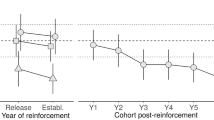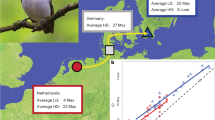Abstract
Immigration into locally adapted populations has been suggested, among other potential causes, to maintain genetic variance in fitness necessary for good-genes models. Using a reciprocal transplant experiment we examined whether females prefer native to transferred males in the grasshopper Chorthippus biguttulus. On average, native and transferred males did not differ in their attractiveness, measured as female response rate to playbacks of male acoustic courtship signals. In line with this result, we found no significant effect of transfer on body size, condition, fluctuating asymmetry or song traits. However, the reciprocal transplant experiment showed that environmental conditions did influence body condition and maximum loudness of the calling song, but that the genetic origin of male grasshoppers had no significant effect on any of the analysed traits.


Similar content being viewed by others
References
Andersson M (1994) Sexual selection. Princeton University Press, Princeton, N.J.
Bensch S, Hasselquist D, Nielsen B, Hansson B (1998) Higher fitness for philopatric than for immigrant males in a semi-isolated population of great reed warblers. Evolution 52:877–83
Charlesworth B (1987) The heritability of fitness. In: Bradbury JW and Andersson MB (eds) Sexual selection: testing the alternatives. Wiley, Chichester, UK, pp 21–44
Clark DC, DeBano SJ, Moore AJ (1997) The influence of environmental quality on sexual selection in Nauphoeta cinerea (Dictyoptera: Blaberiidae). Behav Ecol 8:46–53
Day T (2000) Sexual selection and the evolution of costly female preferences: spatial effects. Evolution 54:715–730
De Kogel CH, Prijs HJ (1996) Effects of brood size manipulations on sexual attractiveness of offspring in the zebra finch. Anim Behav 51:699–708
Dodd DMB (1989) Reproductive isolation as a consequence of adaptive divergence in Drosophila pseudoobscura. Evolution 43:1308–1311
Droney DC (1996) Environmental influences on male courtship and implications for female choice in a lekking Hawaiian Drosophila. Anim Behav 51:821–830
Ehrman L, White MM, Wallace B (1991) A long-term study involving Drosophila melanogaster and toxic media. Evol Biol 25:175–209
Fisher RA (1930) The genetical theory of natural selection. Clarendon Press, Oxford
Foster SA (1999) The geography of behaviour: an evolutionary perspective. Trends Evol Ecol 14:190–195
Garcia-Berthou E (2001) On the misuse of residuals in ecology: testing regression residuals vs. the analysis of covariance. J Anim Ecol 70:708–711
Green AJ (2001) Mass/length residuals: measures of body condition or generators of spurious results? Ecology 82:1473–1483
Griffith SC, Owens IPF, Burke T (1999) Environmental determination of a sexually selected trait. Nature 400:358–359
Hamilton WD, Zuk M (1982) Heritable true fitness an bright birds: a role for parasites? Science 218:384–387
Helversen D von, Helversen O von (1994) Forces driving coevolution of song recognition in grasshoppers. Fortschr Zool 39:254–284
Hoikkala A, Isoherranen E (1997) Variation and repeatability of courtship song characters among wild-caught and laboratory-reared Drosophila montana and D. littoralis males (Diptera: Drosophilidae). J Insect Behav 10:193–202
Houde AE, Endler J A (1990) Correlated evolution of female choice between two guppy populations. Science 248:1405–1408
Ingvarsson PK, Whitlock MC (2000) Heterosis increases the effective migration rate. Proc R Soc Lond B 267:1321–1326
Iwasa Y, Pomiankowski A, Nee S (1991) The evolution of costly mate preferences. II The “handicap” principle. Evolution 45:1431--1442
Klappert K, Reinhold K (2003) Acoustic preference functions and sexual selection on the male calling song of the grasshopper Chorthippus biguttulus. Anim Behav 65:225–233.
Kokko H, Brooks R, McNamara JM, Houston AI (2002) The sexual selection continuum. Proc R Soc Lond B 269:1331–1340
Kriegbaum H (1989) Female Choice in the Grasshopper Chorthippus biguttulus. Naturwissenschaften 76:81–82
Kurtz J, Klappert K, Schneider W, Reinhold K (2002) Immune defence dispersal and local adaptation. Evol Ecol Res 4:431–439
Lesna I, Sabelis MW (1999) Diet-dependent female choice for males with ‘good-genes’ in a soil predatory mite. Nature 401:581–584
Luyten PH, Liley NR (1991) Sexual selection and competitive success of male guppies (Poecilia reticulata) from four Trinidad populations. Behav Ecol Sociobiol 28:329--336
Markow TA, Toolson EC (1990) Temperature effects on epicuticular hydrocarbons and sexual isolation in Drosophila mojavensis. In: Barker JSF (ed) Ecological and evolutionary genetics of Drosophila. Plenum Press, New York, pp 315–333
Olvido AE, Mousseau TA (1995) Effect of rearing environment on calling-song plasticity in the striped ground cricket. Evolution 49:1271–1277
Palmer AR, Strobeck C (2003) Fluctuating asymmetry analyses revisted. In: Polak M (ed) Developmental instability (DI): causes and consequences. Oxford University Press, Oxford, pp 279-319
Phillips PC (1996) Maintenance of polygenetic variation via a migration-selection balance under uniform selection. Evolution 50:1334–1339
Proulx SR (1999) Mating systems and the evolution of niche breadth. Am Nat 154:89–98
Proulx SR (2001) Female choice via indicator traits easily evolves in the face of recombination and migration. Evolution 55:2401–2411
Ptacek MB, Travis J (1997) Mate choice in the sailfin molly Poecilia latipinna. Evolution 51:1217–1231
Reinhold K (2004) Modelling a version of the good genes hypothesis: choice of locally adapted males. Org Divers Evol 4:157–163 2004
Rowe L, Houle D (1996) The lek paradox and the capture of genetic variance by condition dependent traits. Proc R Soc Lond B 263:1415–1421
Rupp JC, Woolhouse MEJ (1999) Impact of geographical origin on mating behaviour in two species of Biomphalaria (Planorbidae: Gastropoda). Anim Behav 58:1247–1251
Shirley MDF, Sibly RM (1999) Genetic basis of a between-environment trade-off involving resistance to cadmium in Drosophila melanogaster. Evolution 53:826–836
Storfer A, Cross J, Rush V, Caruso J (1999) Adaptive coloration and gene flow as a constraint to local adaptation in the streamside salamander Ambystoma barbouri. Evolution 53:889–898
Swaddle JP, Witter MS, Cuthill IC (1994) The analysis of fluctuating asymmetry. Anim Behav 48:986–989
Taylor GC, Williams GC (1982) The lek paradox is not resolved. Theor Pop Biol 22:392–409
Vamosi SM, Schluter D (1999) Sexual selection against hybrids between sympatric stickleback species: evidence from a field experiment. Evolution 53:874–879
Verhulst S, van Eck HM (1996) Gene flow and immigration rate in an island population of great tits. J Evol Biol 9:771–782
Wagner WE, Hoback WW (1999) Nutritional effects on male calling behaviour in the variable field cricket. Anim Behav 57:89–95
Acknowledgements
We are grateful to Dagmar and Otto von Helversen and Leif Engqvist for discussion and helpful advice. Financial support from the Deutsche Forschungsgemeinschaft (RE 1167/3–1) is gratefully acknowledged and we thank Uwe Schmidt for lending us a B&K sound level meter. We also thank Antje Nemetschek for her help with the experiments. Theo Bakker, Bernhard Misof, Marc Zbinden, Leigh Simmons and five anonymous referees gave invaluable comments on previous versions of the manuscript. All experiments comply with the laws of Germany.
Author information
Authors and Affiliations
Corresponding author
Additional information
Communicated by L. Simmons
Rights and permissions
About this article
Cite this article
Klappert, K., Reinhold, K. Local adaptation and sexual selection: a reciprocal transfer experiment with the grasshopper Chorthippus biguttulus. Behav Ecol Sociobiol 58, 36–43 (2005). https://doi.org/10.1007/s00265-004-0902-6
Received:
Revised:
Accepted:
Published:
Issue Date:
DOI: https://doi.org/10.1007/s00265-004-0902-6




